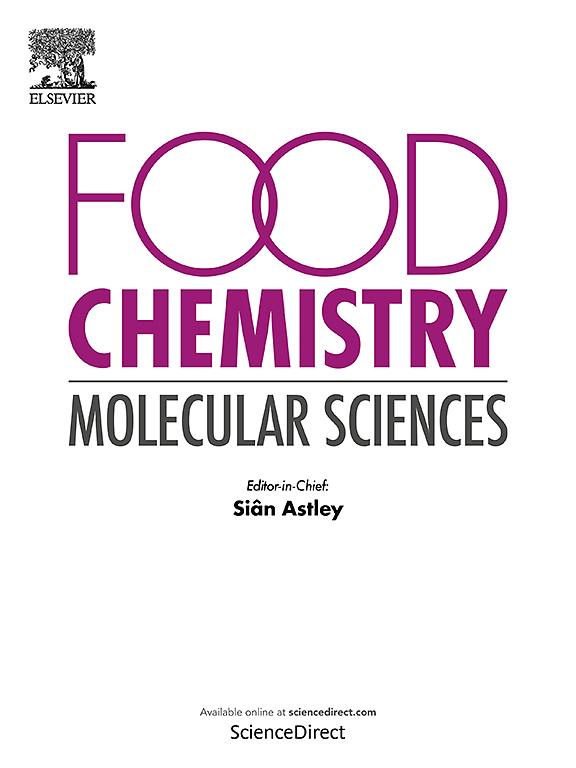Semi-rational engineering of an α-L-fucosidase for regioselective synthesis of fucosyl-N-acetylglucosamine disaccharides
IF 4.1
Q2 FOOD SCIENCE & TECHNOLOGY
引用次数: 0
Abstract
α-L-Fucosidases are attractive biocatalysts for the production of bioactive fucosylated oligosaccharides, however, poor regioselectivity and activity for transglycosylation have significantly limited their applications. We have recently derived an α-L-Fucosidase, BF3242, from Bacteroides fragilis NCTC9343, which could efficiently synthesize a mixture of Fuc-α-1,3/1,6-GlcNAc, but its 1,3/1,6-regioselectivity was observably affected by reaction temperature. Here, we integrated loop-targeted random mutagenesis and site-directed mutagenesis to engineer the regioselectivity and transglycosylation activity of BF3242. Loop-targeted random mutagenesis revealed that L266 in the loop-4 (H242-S267) within the model of BF3242 was a key residue for the regioselectivity for transglycosylation, and the saturation mutagenesis at residue L266 uncovered a mutant L266H with a significantly increased 1,3-regioselectivity of 97 % from 69 % of WT BF3242. Subsequently, five designed single-site mutations at the putative aglycone subsites were performed, resulting in a double-site mutant L266H/M285C that increased the overall yield of Fuc-α-1,3/1,6-GlcNAc to 76 % from 68 % of WT BF3242. The saturation mutagenesis at residue M285 finally generated a double-site mutant L266H/M285T with the maximal overall yield of Fuc-α-1,3/1,6-GlcNAc of 85 % and 1,3-regioselectivity of 98 %. The RT/H of L266H/M285T was approximately 2.7-fold higher than that of the WT BF3242. Molecular dynamics simulations revealed that the structural flexibility of the loop-4 was substantially reduced in mutant L266H, and the hydrogen bond formation and binding affinity between mutant L266H/M285T and Fuc-α-1,3-GlcNAc was significantly enhanced. The semi-rationally engineered enzyme L266H/M285T would be a promising biocatalyst for highly 1,3-regioselective synthesis of fucosyl-N-acetylglucosamine disaccharide.

α-L-岩藻糖苷酶的半理性工程,用于岩藻糖基-N-乙酰葡糖胺二糖的区域选择性合成
α-L-聚焦酶是生产具有生物活性的聚焦型低聚糖的生物催化剂,但其较差的区域选择性和转糖基化活性极大地限制了其应用。最近,我们从脆弱拟杆菌NCTC9343中获得了α-L-聚焦酶BF3242,该酶能高效合成Fuc-α-1,3/1,6- glcnac混合物,但其1,3/1,6-区域选择性受反应温度影响较大。在这里,我们整合了环靶向随机诱变和位点定向诱变来设计BF3242的区域选择性和转糖基化活性。环靶随机诱变发现,BF3242模型中环4 (H242-S267)中的L266是转糖基化区域选择性的关键残基,在L266残基上进行饱和诱变发现突变体L266H的1,3-区域选择性从WT BF3242的69%显著提高到97%。随后,在假定的苷元亚位上进行了5个设计的单位点突变,产生了一个双位点突变体L266H/M285C,将Fuc-α-1,3/1,6- glcnac的总产量从WT BF3242的68%提高到76%。在残基M285处进行饱和诱变,最终产生了一个双位点突变体L266H/M285T,其Fuc-α-1,3/1,6- glcnac的最大总产量为85%,1,3-区域选择性为98%。L266H/M285T的RT/H比WT BF3242高约2.7倍。分子动力学模拟表明,突变体L266H中环-4的结构柔韧性大幅降低,突变体L266H/M285T与Fuc-α-1,3- glcnac之间的氢键形成和结合亲和力显著增强。半合理工程酶L266H/M285T是一种具有高度1,3-区域选择性合成焦酰基- n -乙酰氨基葡萄糖二糖的生物催化剂。
本文章由计算机程序翻译,如有差异,请以英文原文为准。
求助全文
约1分钟内获得全文
求助全文
来源期刊

Food Chemistry Molecular Sciences
Agricultural and Biological Sciences-Food Science
CiteScore
6.00
自引率
0.00%
发文量
83
审稿时长
82 days
期刊介绍:
Food Chemistry: Molecular Sciences is one of three companion journals to the highly respected Food Chemistry.
Food Chemistry: Molecular Sciences is an open access journal publishing research advancing the theory and practice of molecular sciences of foods.
The types of articles considered are original research articles, analytical methods, comprehensive reviews and commentaries.
Topics include:
Molecular sciences relating to major and minor components of food (nutrients and bioactives) and their physiological, sensory, flavour, and microbiological aspects; data must be sufficient to demonstrate relevance to foods and as consumed by humans
Changes in molecular composition or structure in foods occurring or induced during growth, distribution and processing (industrial or domestic) or as a result of human metabolism
Quality, safety, authenticity and traceability of foods and packaging materials
Valorisation of food waste arising from processing and exploitation of by-products
Molecular sciences of additives, contaminants including agro-chemicals, together with their metabolism, food fate and benefit: risk to human health
Novel analytical and computational (bioinformatics) methods related to foods as consumed, nutrients and bioactives, sensory, metabolic fate, and origins of foods. Articles must be concerned with new or novel methods or novel uses and must be applied to real-world samples to demonstrate robustness. Those dealing with significant improvements to existing methods or foods and commodities from different regions, and re-use of existing data will be considered, provided authors can establish sufficient originality.
 求助内容:
求助内容: 应助结果提醒方式:
应助结果提醒方式:


